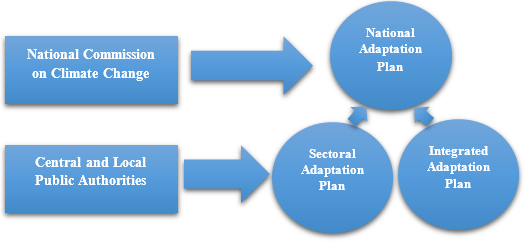The basic tasks and functions of the NCCC are:
- implementing the coordination mechanism of the climate change adaptation process;
- coordinating sectoral adaptation plans and monitoring sectoral adaptation integration efforts in planning (integration);
- monitoring national and sectoral prioritization of climate change adaptation areas and measures, and corresponding to the implementation of actions, interventions and other climate change adaptation modalities to sectoral and national priorities;
- developing and implementing the monitoring, evaluating and reporting framework on climate change adaptation;
- monitoring the allocation of external resources and budgeting national resources for climate change adaptation;
- annual reporting to the Parliament regarding the progress made in adapting to climate change and adequate mitigation actions at national level;
- reporting to the United Nations Framework Convention on Climate Change Secretariat on the progress in adapting to climate change and mitigating action at national level, etc.
Based on the SAP and the IAP, the National Commission on Climate Change, through the Committee's Secretariat, develops the NAP, which includes common activities across sectors and that aim to facilitate sector and local adaptation: eg. sectoral assessments, capacity building, technology implementation, research, publications, consultations, reporting, etc. These activities will be considered as enabling/ support activities within sectoral plans.
Ministries and local public authorities are responsible for developing and approving a SAP every four years, according to the general planning cycles or integrating adaptation measures into their own sectoral development plans (IAPs).
Prior to approval, the SAP consults the NCCC in order to ensure their alignment with the Climate Change Adaptation Strategy of the Republic of Moldova.
As a result of the consultation, the NCCC issues favorable/ unfavorable opinions, summarizing all the views of the members of the Committee and of the experts of the Competent Technical Committee (regarding Climate Change Adaptation and/or Climate Change Mitigation) and, where appropriate, recommendations for improvement.
Regardless of the adopted approach (SAP or IAP), the ministries identify a set of priority adaptation actions to be implemented on a continuous basis. At the end of the planning period, each ministry reports on its actions on climate change to the National Commission on Climate Change via the informational monitoring, evaluating and reporting system.

The link between NAP and SAP
The actions included in the NAP and SAP/IAP must be developed as a response to the different impacts that climate change may have on the given sector and on the various social groups (including women, children, the elderly, people with disabilities). Prioritization of adaptation measures is done by sectors or stakeholders involved in the development and implementation of NAP and SAP. Whenever a NAP or a SAP is proposed, it must contain priority actions for that planning period. The process of determining prioritization and selecting some adaptation options to others must be transparent and based on streamlined criteria. Prioritization exercises of adaptation actions are carried out by a stakeholder group that can take into account considerations from different economic, environmental, social, cultural or political spheres and concerns, as well as cost-benefit analysis (CBA) cost-effectiveness analysis(CEA); Multi-Criteria Decision Analysis (MCDA) and other relevant econometric evaluation methods and tools.
The Roadmap for each NAP is developed on the basis of sectoral assessments, including in accordance with the impact on social groups, and is submitted for discussion between different sectoral partners. The purpose of the roadmap is to reach consensus on the general model and the approach adopted for the planning of the NAP process in Moldova.
Ministries and local public administration authorities are directly responsible for executing the actions provided in the NAP, SAP/IAP. The Climate Change Adaptation Coordination Mechanism (CCACM) implemented by the NCCC and created to act on the basis of the NAP cyclical process, ensures the link between the planning and the implementation of the sectoral/ national and sub-national adaptation.
The NAP and SAP are implemented from the state and local budget sources allocated annually, including from external donor resources.
![]()
